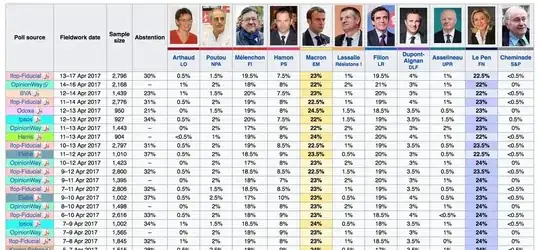With the upcoming French presidential election (first round on 23th of April 2017) many opinion polls are ordered and presented in the news. There are several initiatives to track the results of these polls, see Les Décodeurs or Wikipedia.
The following table sums up 20 most recent results for the 11 eleven candidates from polls published by 7 distinct poll offices:
These polls display a remarkable consistency and the widest variation in the results series for a given candidate is of 2,5% over the last week. I find this form of consistency (used here in the layman sense!) very puzzling:
How likely is it that so many polls display such a high consistence?
I gathered a few facts about the methodology used and other conditions:
About $44$ millions ($44\times10^6$) are expected to vote.
Most offices recruit their sample via an Internet platform and reward the recruits (either with a tiny amount of money or a small gift). For instance, Opinion Way can reward recruits with 0,50€ (p.2, in French)
Some offices use rolling samples, where each day a sample of about 500 recruits is selected and whose answers are cumulated with the answers of the samples in the last days. The period concerned is documented by the “Fieldwork date” in the table. As you can see, these periods overlap (e.g. for Ifop-Fiducial at the top, the period for 11th-14th overlaps with the period for 13th-17th).
Offices work with the “méthode des quotas” which means that some variables (sex, age, social category, residence category and residence area), when observed on the sample, match closely the national statistics provided by the INSEE the National Institute of Statistics and Economic Studies in France.
Offices use several sample bias corrections, some of them being publicly alleged – e.g. the sample can be unbiased using poll results from the previous presidential election – some of them being “in-house” methods.
Poll results publication do not follow the standards of scientific publications, nevertheless the raw results must be communicated to a governmental instance built of judges (but not of statisticians) say.
Standard deviations are not provided. Many results however provide a margin of error table. See Opinion Way p. 4, Ipsos p. 3 or Ifop-Fiducial p. 3. These tables seem to assume that the standard deviation is given by $\sqrt{p(1-p)/N}$ where $p$ is the point estimate and $N$ the size of the sample. Cf. How do you decide the sample size when polling a large population? for the relation between margin of error for a 95% confidence interval and standard deviation.
